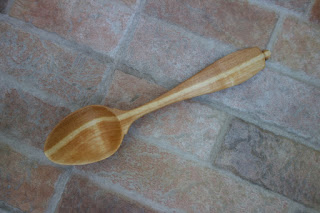1) Will I have splinters stuck in my tongue if I use a wooden spoon?
When I say "wood", many people imagine rough sawn planks bristling with splinters:
However, the surface depends on the used tools. A saw leaves such splinters because every tooth cuts and tears the wood fibers. But spoons are not carved with a saw! If you have suitable wood, a sharp knife and some skill, the surface of the spoon can be smoother than a smartphone display and there will be no splinters at all. The spoon can be additionally sanded and polished, but that's just for surface finishing, not for removing splinters.
For example, these spoons are not sanded:
2) To sand or not to sand?
Nowadays it seems to be cool and trendy not to use any sandpaper. It kinda makes sense - if someone carves spoons for sale, he wants to make them as fast as possible and skip all the unnecessary steps. Proper sanding and polishing takes hours and if you skip it, you may save as much as one third of crafting time. And of course such craftsman will tell the customers that this is the best way to carve spoons. Besides, many people consider it an ultimate proof of skills if you can carve spoons that don't need to be sanded.
Sanding has a bad reputation because it is often used for hiding someone's carving mistakes. But let's face it - an ugly spoon will remain ugly no matter how much sandpaper you waste on it.
So if someone tries to convince you that sandpaper is ultimate evil, don't take that too seriously. It is just a matter of personal preference. Some people love faceted texture of knife cuts while others prefer uniform polished surface. I usually prefer sanded spoons because they are easier to wash. But I prefer unsanded spoons when:
- the wood itself does not polish well (like cherry, basswood)
- the wood is pale and without grain patterns (then the spoon is more interesting with faceted surface)
3) What kind of sandpaper should I use?
Sandpaper is produced in various grit sizes, around 15-2000. The number indicates the amount of the abrasive material that can fit through a square inch filter, so larger number means that the grains are smaller and the grit is finer.
Some internet manuals will tell you that you must sand the spoon with grits 80, 120, 240, 360, 400, 600, 1000, 2000 and you can't skip any of them. But that rule is not universal. It depends on the wood and also on the quality of the sandpaper itself.
For example, I seldom use grit 80 because it is too coarse for my taste and it leaves deep, ugly scratches. If the wood is quite soft (like willow), then I skip the 120 as well. I don't use my 240 grit sandpaper because it wears out very quickly (but maybe I just happened to buy some low-quality brand). I also skip 400 because it is too similar to 360, so the effort does not pay off. So I sand harder woods with 120, 360, 600 and then polish with 2000. For softer woods I use only 360, 600 and 2000. I recommend buying more different grits and brands in the beginning and to test what works best for you.
4) How to do it right?
I'm sure there are many good ways but this is what works for me.
Cut a strip 6-8cm wide (use some old scissors because the blades will get scratched by the coarser grits). Then fold the strip into a flat roll 6-8cm long and 1-2cm wide. This can be used to sand the outer walls. The folded paper is tough, it does not crumple under the fingers, but it is flexible enough to adjust to the spoon curves. When the outer layer wears out, you can cut it off and reveal the next layer.
When you move on to the next grit, make sure to remove any scratches that remained from the previous grit. When it's hard to tell if the scratches are old or new, you can just change the direction of the sanding.
After grit 600 the spoon will look and feel smooth but you are not there yet. Wash the spoon and let it dry. The fibers torn by the sandpaper will rise, the spoon will feel hairy and it must be re-sanded with grit 600. This step must be repeated until the spoon is smooth enough even after washing. The number of iterations depends on the wood. For example, lilac and hornbeam are smooth after two iterations while cherry is not good enough even after 10 of them (that's why I recommend not to sand cherry, it's just too much trouble).
Finally polish the spoon with grit 2000 and it can be finished with oil.
5) But how do I sand the inside of the bowl?
Cut a strip of sandpaper as wide as your index finger. You can fix it to your finger with tape or just hold it in place with other fingers. Then you can sand with your fingertip. You may have to use coarser grit in the beginning because sanding the inside is a little harder. The sandpaper strips also wear out quite quickly this way because they crumple a lot.
6) How can I tell if the spoon is sanded well?
Sanding might seem easy, but it also needs some practice. There are several common mistakes:
- visible scratches on the finished spoon (someone was lazy to remove them :D)
- sporadic grooves inside the bowl (those are some unfortunate cuts with a spoon knife, they are almost impossible to sand off)








